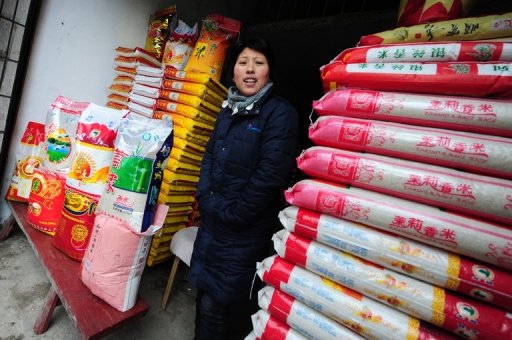With drought parching farms in the United States and near the Black Sea, weak monsoon rains in India and insidious hunger in Africa’s Sahel region, the world could be headed towards another food crisis, experts say.
Asia should keep a catastrophe at bay with a strong rice harvest while the G20 group of industrialized and emerging economies tries to parry the main threat, soaring food prices.
In India, “all eyes will be on food inflation – whether the impact of a weak monsoon feeds into food prices,” Samiran Chakraborty, regional head of research at Standard Chartered Bank was quoted by Dow Jones Newswires as saying.
Monsoon rains were 15.2 percent below average in mid-August, according to latest data from India weather bureau, and Asian rice prices are forecast to rise by as much as 10 percent in the coming months as supplies tighten.
India and Thailand are two of Asia’s leading rice exporters.
Indian Food Minister Kuruppasserry Varkey Thomas told parliament this month that prevailing conditions “could affect the crop prospects and may have an impact on prices of essential commodities.”
Despite that warning however, the UN Food and Agricultural Organization expects rice output to slightly surpass “excellent results” recorded last year, though the FAO cut its global forecast for production of unmilled rice to about 725 million tons from its previous figure of 732 million.
The world is feeling the onset of the El Nino weather phenomenon, which has a natural warming effect, is active in the western Pacific and expected to last until winter in the northern hemisphere, according to Japanese meteorologists.
The US farm belt has been ravaged by the most stifling drought since the 1950s, and the country’s contiguous 48 states have just sweltered through the hottest July on record.
Corn production is probably at the lowest level in six years, the US Department of Agriculture said, and curtailed production will likely send corn and soybean prices to record highs, it added.
Commerzbank commodity experts said high temperatures and drought around the Black Sea “have resulted in wheat crop shortfalls on a scale that cannot yet be predicted with any accuracy.”
US commodities analyst, AgResource Company president Dan Basse told the Australian Broadcasting Corporation last week that the Australian harvest could play a role in easing the food shortage.
Jean-Rene Buisson, head of France’s national association of food industries (ANIA) said: “All products based on cereals, including meat, will be affected by price increases, not necessarily by September, but definitely during 2013.”
In China, food prices are considered politically sensitive and account for up to a third of a consumer’s average monthly budget, government statistics show.
China has reined in inflation as its economy slows however, while its grain output stood at 1.3 trillion tonnes in the first half of the year, up 2.8 percent from the same period a year earlier.
The Financial Times (FT) said concerns over the US harvest had prompted senior G20 and United Nations officials to consider an emergency meeting on food supply, with a conference call on the issue scheduled for August 27.
The newspaper cited officials as saying the talks were not a sign of panic but rather reflected the need to establish a consensus to avoid a repeat of the riots and tensions sparked in 2007-08 by spiking food prices.
Major concerns include hoarding or export restrictions by food producing countries, along with panic buying by others.
Also crucial is the balance between the use of grain as a direct source of food and its role as animal feed or as a basis for motor fuels.
FAO director general Jose Graziano da Silva of Brazil called in the FT for the United States to suspend biofuel production programmes to ease the pressure on food resources.
A region where food is in chronic shortage is the Sahel region of Africa, where the number of malnourished children is estimated to have hit a new high of 1.5 million as cholera and locusts emerge as new threats, UNICEF has warned.
The relief agency World Vision Australia said 18 million people need food assistance in Niger, Mali, Chad, Mauritania and Senegal.

COMMENTS
Please let us know if you're having issues with commenting.